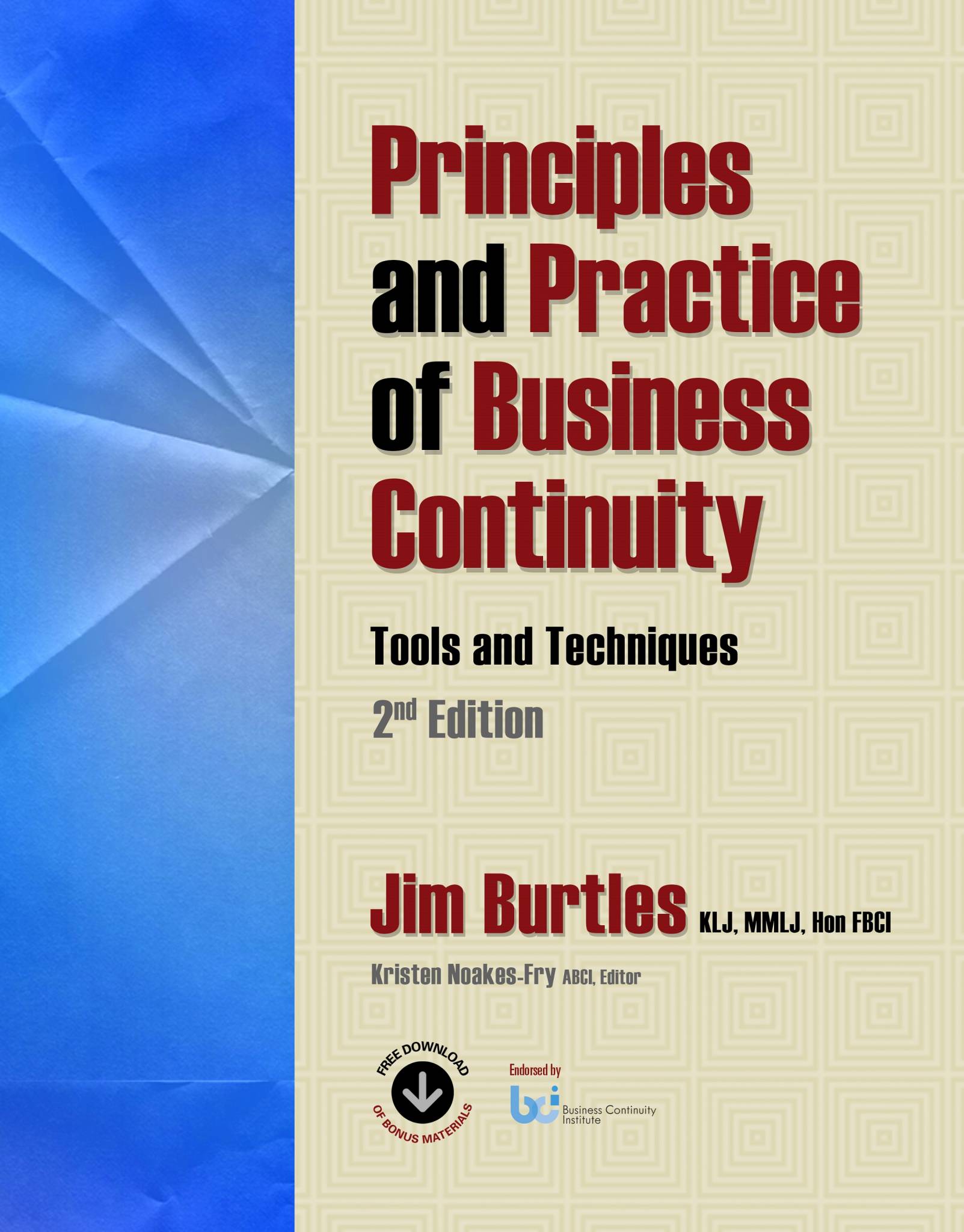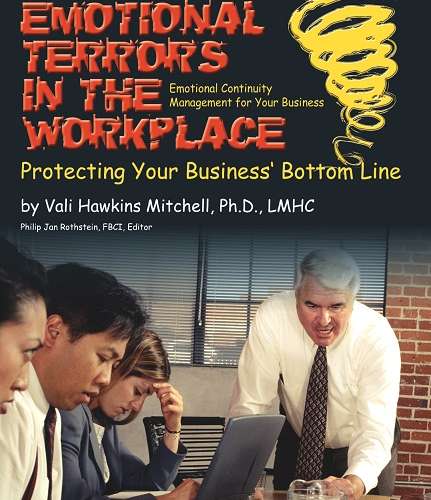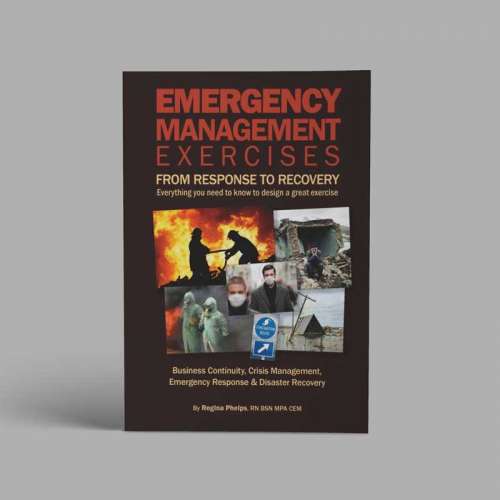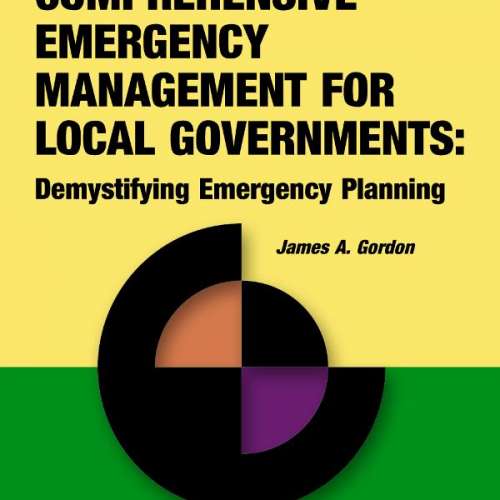Description
Are you are a Business Continuity Manager or training for the job? Are you ready to keep the business up and running in the face of emergencies ranging from earthquakes to accidents to fires to computer crashes?Do you need a comprehesnive yet practical business continuity textbook?
In this second edition of this business continuity textbook Principles and Practice of Business Continuity: Tools and Techniques, Jim Burtles explains six main scenarios. He promises: “If you and your organization are prepared to deal with these six generic risks, you will be able to recover from any business disaster.”
Using his decades of experience, Burtles speaks to you directly and personally, walking you through handling any contingency. He tells you how to bring people together to win executive support, create a Business Continuity Plan, organize response teams, and recover from the disruption. His simple, step-by-step actions and real-world examples give you the confidence to get the job done.
Principles and Practice of Business Continuity: Tools and Techniques is organized with all the features you need:
- Each chapter starts with learning objectives and ends with a multiple-choice self-examination covering the main points.
- Thought-provoking exercises at the end of each chapter help you to apply the materials from the chapter to your own experience.
- A glossary of the key terms currently in use in the industry and a full index allow for more depth of study.
- A downloadable the Business Continuity Toolkit offers wealth of extra online material prepared specially for you by Jim Burtles.
Principles and Practice of Business Continuity: Tools and Techniques includes your valuable DOWNLOADABLE* BUSINESS CONTINUITY TOOLKIT!
(* Registration Required)
Principles and Practice of Business Continuity: Tools and Techniques includes extensive INSTRUCTIONAL MATERIAL**
(** Available to qualified instructors and professors on approval and confirmed adoption)
The book is organized around the phases of planning for and achieving resiliency in an organization:
Part I: Preparation and Startup
- Learn the essentials of the Business Continuity discipline and profession and the practical basic information that will help you move fast to achieve results.
Part II: Building a Foundation
- Gather and analyze the information you need to identify possible threats, deal with the symptoms, and take steps to prevent the consequences.
Part III: Responding and Recovering
- Organize resources, teams, and facilities to protect, recover, and restore critical business activities.
Part IV: Planning and Implementing
- Create the plans that are at the heart of your Business Continuity program. Manage plans, resources, and people for a BC capability that will stand the test of time.
Part V: Long-term Continuity
- Move beyond basic planning to audit and maintain capabilities, enhance governance, and prepare for a rewarding career in Business Continuity.
2016, 460 pages plus extensive, downloadable content available on registration. ISBN 978-1-931332-94-1.
About the Author
Jim Burtles KLJ, MMLJ, Hon FBCI is a well-known and respected leader within the business continuity profession. Now semi-retired and living in West London, he can look back and reflect upon the lessons learned from a wealth of experience gained in some 40 years of practice, spread across 4 continents and 24 countries. He was granted Freedom of the City of London in 1992, received a Lifetime Achievement Award in 2001, and was awarded an Honorary Fellowship by the Business Continuity Institute (BCI) in 2010. In 2005, he was granted the rank of a Knight of Grace i
West London, he can look back and reflect upon the lessons learned from a wealth of experience gained in some 40 years of practice, spread across 4 continents and 24 countries. He was granted Freedom of the City of London in 1992, received a Lifetime Achievement Award in 2001, and was awarded an Honorary Fellowship by the Business Continuity Institute (BCI) in 2010. In 2005, he was granted the rank of a Knight of Grace i
n the Military and Hospitaller Order of St. Lazarus of Jerusalem, an ancient and charitable order which cares for those afflicted with leprosy and similar debilitating diseases.
Working as an IBM field engineer, in the mid-70s he took on the role of a rescue engineer, helping customers recover their damaged systems in the wake of fires, floods, and bombings. This type of work was the beginning of what later became known as disaster recovery. During the 80s, he became an early pioneer of what was then the emerging business continuity profession. In 1994 he helped to found the Business Continuity Institute (BCI) and now serves on its Global Membership Council, representing the interests of the worldwide membership. His practical
experience includes hands-on recovery work with victims of traumatic events such as explosions,
earthquakes, storms, and fires. This includes technical assistance and support in 90-odd disasters, as well as advice and guidance for clients in over 200 emergency situations.
Over the past 40 years, Jim Burtles has introduced more than 3,500 people into the business continuity profession through formal training programs and has provided specialist training for another 800 or so through workshops covering specific subjects or skill areas. For several years he was a regular visiting lecturer at Coventry University.
Recent published works include Coping with a Crisis: A Counselor’s Guide to the Restabilization Process, 2011, and Emergency Evacuation Planning for Your Workplace: From Chaos to Life-Saving Solutions, published by Rothstein Publishing in August 2013.
Author's Introduction to the 2nd Edition
The aim of this second edition of Principles and Practice of Business Continuity: Tools and Techniques is to provide a balanced, student-friendly textbook to help you establish yourself as a competent practitioner of business continuity (BC). While philosophy and the principles remain the same, the book has been restructured and updated in five parts to represent the five main phases of learning and development. Each part consists of three or four chapters devoted to specific areas of knowledge or competence. Techniques are subtly refined to represent current practice with additional information included. To assist you in your learning, you will find discussion questions and useful examples at the ends of chapters, supported by a wealth of downloadable practical material (accessible once you’ve registered your book). Pausing for reflection at regular intervals like this will reinforce the learning process, as well as enable you to evaluate and appreciate your progress.
New material in this edition includes:
- Expanded glossary of terms currently in use in the industry.
- Suggestions for additional reading at the end of each chapter.
- A comprehensive index.
- A new section on governance, exploring how resilience can fit into the larger picture of the organization.
- Information about professional certification options.
- Multiple choice questions at the end of each chapter inviting you to check your understanding.
- A “Food for Thought” section in each chapter letting you apply what you have just read to your experiences at work and in the community.
You will follow my lead in exploring the subject of BC management as I explain the basic principles and describe what my experience has shown to be good practice. By the end of this book, you should be prepared to engage in all of the activities associated with the development, delivery, and maintenance of a sound BC program.
Part I: Preparation and Startup
At the start of the book, you will look at how and why BC came into existence. This glimpse at history leads naturally into some thoughts about the science behind the basic principles. The practical aspect opens up with ideas about launching a program and getting to grips with the operational risks and threats – and understanding the concept of resilience.
Part II: Building a Foundation
- Risk management is a well-established discipline, and much of our BC work is often predicated upon the work done by others in this area. The BC discipline works towards a practical understanding of the impacts and consequences of risk, which leads to designing an appropriate continuity strategy to meet the precise needs of your organization.
- Business impact analysis (BIA) is an especially valuable contribution to the development of continuity and resilience in any enterprise.
- You will explore the basic continuity strategies and how to select the most appropriate one to meet your organization’s needs and the budget.
Part III: Responding and Recovering
- Important in this context is the emergency response aspect, preparing to deal with a business interruption. Understanding the management and control of the effects and consequence of such an event leads you naturally towards the need for restoration and recovery of facilities, resources, and equipment.
- Next, you will look at disaster recovery, the various methods technical people use to rebuild or recover the support services and functions. This is an area in which you, as a BC specialist, may need to rely upon the skills and experience of other professionals.
Part IV: Planning and Implementing
- Armed with a rounded knowledge of the prerequisites, you are ready to develop and construct the actual BC plans based on the types and levels of plans that cover the various aspects of a disruptive event. You will work with a model that has five distinct types of plans, which you can adapt to fit the needs and structure of your organization.
- Having covered the build-up towards – and the actual development and delivery of – the BC plans, you will move on to consider the longer term aspects of the management program, including the process of developing and applying the requisite support and delivery skills, looking after the resources, and keeping the plans up-to-date.
Part V: Long-Term Continuity
- This second edition concludes with a new section on the function of resilience in corporate governance. You will consider the review or audit program as a means of ensuring the ongoing suitability of the system and its components as well as its strategy, plans, and resources. Finally, you will learn what to expect in your future career in BC, your role in the company, and what professional certifications are available to you.
Imagine that you are about to embark on an educational cruise though the world of BC. I am the experienced traveler who has planned your itinerary, this book is your curriculum, and our phase model is an outline map of the lands you will be visiting. If you are working with a tutor or mentor, you should look to that person as your tour guide to ensure that you get to appreciate the landscape and learn about the people, places, and culture you encounter along the way. By the end of the journey, you should be familiar with all aspects of BC, ready to advise and guide others.
Jim Burtles
London, United Kingdom
February, 2016
Instructional Materials
Upon confirmed classroom adoption and acceptance of an Instructor License Agreement, the following Instructional Materials are available to accompany Principles and Practice of Business Continuity: Tools and Techniques, 2nd Ed., by Jim Burtles.
Sample chapters of these materials are available for evaluation purposes along with a review copy of the book. Click on the Complimentary Copy form below to request your copies.
- Instructor’s Manual
- Test Bank Questions andAnswers
- PowerPoint Slides
- Free Downloadable Toolkit
www.rothstein.com/complimentary-copy-request-principles-and-practice-of-business-continuity-2nd-ed/
Foreword by Owen Gregory
Foreword
The time that has passed since the first edition of Burtles’ Principles and Practice of Business Continuity: Tools and Techniques was released (2007) has witnessed countless changes in organizational governance, business structure, and corporate goals.
Working as a shift leader on Honeywell Level 64 mainframes in the late 1970s, I was involved in a few emergency nightshifts of my own, when the room-filling beast of a computer would power itself down for many unknown reasons. I remember that my first action to get the machine up and running again was to open and slam the doors on the shed-sized processor cupboards and open and close the drawer under the operators’ teletype in a tried and tested sequence!
It is difficult at times to believe the changes in working practice and technology that have taken place since then. Each successive update to the technology within an organization has required the business model to drive, or in some companies to follow, that change. As each change to the operational and processing methods employed has taken place, so the business continuity model has been required to mature alongside. Changes have been both internal, as mergers and acquisitions have occurred or business models and methods have changed, and external, as litigation and regulation have shaped commerce. The globalized world in which companies now operate requires an advanced capability of business continuity.
While occasionally tipping its hat to the idea of significant relationships with the other practitioner schools of organizational resilience, this second edition of Principles and Practice of Business Continuity: Tools and Techniques concentrates on the key capability of continuing to deliver products or services at acceptable redefined levels following disruptive incidents – business continuity in a nutshell. Burtles has created an easy-to-follow five-part structure within the book which permits the reader to follow his widely experienced knowledge of the definition, delivery, and maintenance of a business continuity program within an organization.
Burtles offers a brief look at the history of business continuity, which provides an insight into the necessities of establishing business continuity. In addition, he looks at operational risks, identifying the threats and potential impacts if the risk profile becomes active in any way, and introducing the contemporary concept of organizational resilience. In the first few chapters, he establishes the purpose of business continuity, clarifies the association between risk and appropriate continuity strategies, and explains the application of a business impact analysis cycle. Burtles then deals successively with the concepts of emergency response and the design required for restoration and recovery of services and products required by the organization; examples of the plan types that the business practitioner may wish to create against the structure of the organization; and a final chapter that details the means of governance of the business continuity program, both within the organization and in the support of the levels of resilience that management might expect in a modern business. Whether you regard Burtles, himself, as a guide or as a mentor, the results of this book should familiarize you with the various facets and requirements of business continuity creation to a level of excellence.
Chapter by chapter, the book builds knowledge of business continuity management techniques, much in the sequence of the professional practices established by the Business Continuity Institute’s Good Practice Guidelines. Each chapter of the book is complemented by a set of questions and/or exercises to check your understanding – a task that requires organized business continuity thought processes to complete – and suggestions for further reading in the specific subject matter of the chapter. This level of enforcement will ensure understanding and promote best practices in line with Burtles’ ideas and advice.
As a past designer of business continuity management systems, service continuity methods, and operational control systems, I have now moved into the world of lecturing others to do the same. You can rest assured that, by my estimation, this new edition by Burtles can contribute greatly to the systems capability that the business continuity practitioners, both new to the field and currently operating, are expected to design. The Business Continuity Institute’s Good Practice Guidelines provides the current body of knowledge for the profession in terms of how to practice the discipline. In addition, a book such as Principles and Practice of Business Continuity: Tools and Techniques puts the skin on the bones of business continuity and provides wider knowledge of the activities associated with design, development, delivery, and management of business continuity for all sizes and types of organizations.
A part of business continuity is the scanning of the horizon to ensure that the business that you write the continuity management systems for is covered for almost every eventuality. Back when I loaded disk packs and tabulation paper in the back of a Ford Cortina to ensure overnight processing could take place at a reserve site, little did I think that this process would grow into a professional discipline called “business continuity.” I could not have anticipated that business continuity would encounter so many developing challenges of the modern world, not only to meet the needs of the practitioners’ own organizations, but also to permit their companies to remain competitive within the global marketplace at the times of highest stress.
Owen Gregory MBCI MBCS
Senior Lecturer
Buckinghamshire New University
High Wycombe, Buckinghamshire, UK
Foreword by Deborah Higgins, The Business Continuity Institute
Foreword
We’ve all heard the saying “It’s not what you know but who you know.” This saying is true in my case, as it specifically applies to knowing Jim Burtles. As I began my career in emergency management, I first became aware of Jim as a respected author and expert in the field. I must admit that I was a little starstruck when I first met him as my instructor years later in a Business Continuity Institute (BCI) Good Practice Guidelines training course. At the time, I was working in a large public sector organization in the UK. As business continuity (BC) practitioners so often do, I felt a little isolated and despondent and was considering a change in direction.
It was Jim’s enthusiastic teaching and passion for the subject that reignited my own passion for the subject. I realized that I could revive and learn to harness my enthusiasm and, combined with increasing my knowledge and skills, I could demonstrate the value of good BC management and make a difference. Thanks to Jim’s expertise, advice, and positive attitude, I went on to become a certified practitioner and joined the BCI as a member. I would like to thank Jim for unintentionally persuading me to stick with BC as a profession and for introducing me to the BCI, where I am one of the many people Jim has brought into the field.
In this second edition of Principles and Practice of Business Continuity: Tools and Techniques, Jim describes himself as the experienced traveler, but I see him as the experienced guide with some great stories to tell with great lessons built in. Jim takes us on a journey, from the origins of BC to how it is practiced today. Because he is a founder of the discipline and continuing contributor to the growing body of knowledge in BC, with Jim we are in steady hands.
Jim’s friendly narrative and ability to read the minds of the readers provides us with answers to many of the questions we often ask ourselves, such as, “So, what does this mean in practice?” He uses examples to illustrate his recommended approach to the subject along with suggestions for where to go for further information.
A common issue for practitioners is how to get the attention of the top management. For that, Jim’s advice about being a good communicator and the importance of being patient and persistent is invaluable. Another frequent challenge for practitioners is to be able to demonstrate the value of BC and illustrate some return on investment. Jim suggests methods to calculate potential loss, which can be applied in your workplace to help answer those difficult questions.
This new edition builds on and expands on the original by posing questions at the end of each chapter inviting us to check what we have just read, making this book ideal for self-study for practitioners. Jim has written many exam questions as part of the BCI exam development group and knows how to test the reader’s knowledge. I really like the thought-provoking “Food for Thought” sections that encourage readers to think about how they might apply this knowledge. Among other excellent resources, the downloadable Business Continuity Toolkit contains good examples of what can be used in the workplace to help practitioners develop their own documents.
Jim is a founding member of the BCI and key player in the BC profession, and I am lucky enough to now hold a senior position in the BCI myself and to work alongside Jim in many capacities. We have collaborated on developing teaching materials and models, co-presented our work to a global audience, and worked together to develop examination questions for the globally recognized certificate of the BCI (CBCI) credential. I am thrilled to be writing this foreword and happy to be able to give something back to Jim for all the many years he has contributed to the discipline and to my own career.
I would encourage anyone working in the field of BC and resilience to read this newly revised book. It tackles the emerging subject of organizational resilience as a governance issue and states the importance of collaboration between disciplines with which I wholeheartedly agree. Building a network of people and collaborating with others is a consistent message throughout this book and one to which I have listened and continue to follow.
As Head of Learning and Development at the Business Continuity Institute, I have been involved in a number of key industry developments – the Good Practice Guidelines 2013, the British Standard on Crisis Management (BS 11200), and Organizational Resilience (BS 65000) – and most recently as a member of the working group developing the International Standard for organizational resilience. I am proud to represent and to meet many BC professionals all over the world, and I know that this second edition of Principles and Practice of Business Continuity: Tools and Techniques will make an excellent addition to our resources, and should form an essential part of every practitioner’s learning and development.
Deborah Higgins MBCI
Head of Learning and Development
The Business Continuity Institute

Excerpt from Chapter 5: Impacts and Consequences
5.6 Five Step Functional Analysis
A functional analysis exercise is a relatively straightforward way of getting common agreement among the executive staff of what is critical and why it is critical. The process is run as a workshop activity among the executives, with representatives from all of the main business functions.
There are five steps to the process:
- Agree upon the definition of a critical function.
- Agree upon the functional drivers.
- Develop and agree upon the main functions.
- Develop and agree upon relationships for each of the functional drivers.
- Agree upon their criticality according to the definition from step 1.
Your aim is to reach agreement at the end of each step before moving on to the next part of the process. This approach ensures progress without the need for continuous reiteration and argument.
The definition of a critical function can be agreed upon by proposing a self-evident definition and ensuring that everyone understands and accepts the definition. During these discussions, the wording may need to be revised to suit the circumstances, preconceived notions, and the culture of the organization. You might consider including your initial draft definition in, or with, the invitation to participate in the analysis.
5.6.1 Define the Critical Function
Your initial definition could be something like: A critical function is one which performs an essential service in satisfying the core needs of the business, i.e., its output or service is required on a frequent or permanent basis, and delays are not acceptable.
You can expand on this definition to provide a more refined model to allow for varying degrees of criticality. You might, for example, identify two or three levels of criticality, each with its own set of priorities and considerations based on its relationship with other functions.
All of the critical functions would meet the basic definition as above, but further analysis might reveal them to be highly critical or even super critical in some cases. The distinction between these different categories would be the way in which they serve or interrelate with some (or all) of the other critical functions.
A super critical function would be one whose services are essential to the long-term success of the business. We are talking here about the absolute showstopper. For example, the absence of such a super critical function might incur a loss of the license to operate, impose a serious health risk, or cause an infringement of the law. Another way of defining a super critical function would be because it serves several critical functions.
Any function upon which a super critical function depends has to be regarded as highly critical because of its relationship with the super critical function.
Highly critical functions would in turn have their own dependencies. Functions providing essential services to a highly critical function must at least be critical. If they serve a number of highly critical functions then they should also be regarded as highly critical.
Here we are only concerned with the essential service contributions to the dependent function. We are not concerned with subsidiary or minor contributions.
By the end of this first step you should have reached a consensus about the definition(s) of critical functions in the context of your organization.
5.6.2 Agree on the Functional Drivers
The functional drivers are those forces which contribute to the fulfillment of the core purpose or mission of the business. They are unique to each organization, and so it is essential that they be defined and agreed upon as part of this process. However, you can suggest a typical set of such drivers as the basis of your discussion. A few suggestions will give the participants a better idea of what you are looking for. Then they can modify and improve on somebody else’s ideas rather than have to develop their own from scratch. Modification and adaptation are so much easier than original invention.
These basic drivers can be summarized as:
- Cash-flow – contributing to the income or profitability of the company.
- Service – the ability to meet the expectations of customers.
- Operations – the capability to sustain normal operations.
- Image – the public perception or image of the function, the company, and its products or services within the marketplace.
- Compliance – complying with the rules and regulations which are imposed by regulators, legislation, or corporate policy.
Naturally these typical functional drivers may need to be modified or refined to suit the nature of your particular business and style of operation. Almost certainly, there will be concerns about cash-flow and prudent controls in any emergency situation.
After some discussion, you should reach agreement about these functional drivers – the invisible forces driving the business towards its destination…
Reviews
Those practicing in the disaster recovery and business continuity fields have benefited for more than 40 years from the experience and expertise of Jim Burtles via top-drawer training and guidebooks. Now semi-retired, he continues to contribute to the field by authoring the second edition of Principles and Practice of Business Continuity: Tools and Techniques.
Burtles clearly demonstrates how business continuity planning fits within a larger emergency planning context, including risk management, crisis management, emergency response, business recovery, and other disciplines that together form a comprehensive whole. Concentrating on the business recovery area, Burtles takes readers from preparation through planning, response, and recovery – emphasizing the need for resilience and how that applies to corporate governance.
Full review appears in the February 2017 Print Issue of Security Management Magazine.
//sm.asisonline.org/Pages/Book-Review—Business-Continuity.aspx
Reviewer: Mayer Nudell, CSC (Certified Security and Safety Consultant), is an independent consultant on crisis management, contingency planning, and related issues. He is an adjunct professor at Webster University and a member of ASIS.


 West London, he can look back and reflect upon the lessons learned from a wealth of experience gained in some 40 years of practice, spread across 4 continents and 24 countries. He was granted Freedom of the City of London in 1992, received a Lifetime Achievement Award in 2001, and was awarded an Honorary Fellowship by the Business Continuity Institute (BCI) in 2010. In 2005, he was granted the rank of a Knight of Grace i
West London, he can look back and reflect upon the lessons learned from a wealth of experience gained in some 40 years of practice, spread across 4 continents and 24 countries. He was granted Freedom of the City of London in 1992, received a Lifetime Achievement Award in 2001, and was awarded an Honorary Fellowship by the Business Continuity Institute (BCI) in 2010. In 2005, he was granted the rank of a Knight of Grace i


